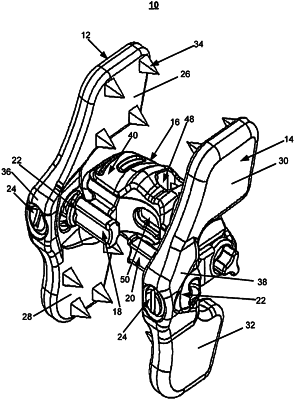| CPC A61F 2/4465 (2013.01) [A61B 17/7062 (2013.01); A61B 17/7065 (2013.01); A61B 17/7068 (2013.01); A61F 2002/30433 (2013.01); A61F 2002/30538 (2013.01); A61F 2002/30579 (2013.01)] | 20 Claims |

|
1. A method of surgically stabilizing adjacent vertebral bodies, said method comprising:
providing an implantable device, the implantable device including:
a barrel having a longitudinal axis;
a first plate having multiple projections extending from the first plate and configured to engage a spinous process of the adjacent vertebral bodies, the first plate configured to movably couple to the barrel; and
a second plate having multiple projections extending from the second plate and configured to be engage the spinous process of the adjacent vertebral bodies, the second plate configured to movably couple to the barrel,
wherein the barrel is configured to transition from a collapsed form having a first height to an expanded form having a second height, wherein the barrel comprises a first endplate, a second endplate, an actuator positioned between the first endplate and the second endplate, wherein the actuator includes a first ramp and a second ramp for abutting one of either the first end plate or the second endplate such that driving of the actuator along the longitudinal axis causes expansion of the barrel,
wherein the first and second plates are configured to move independently of each other;
inserting the implantable device into an interspinous space between the adjacent vertebral bodies; and
expanding the barrel from the first height to the second height using the actuator in the interspinous space to provide an interspinous distraction in order to reduce a load placed on the spinous process by the first and second plates so as to reduce a chance of breaking the spinous process.
|